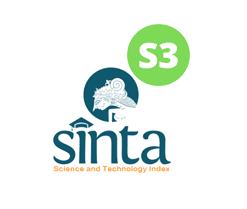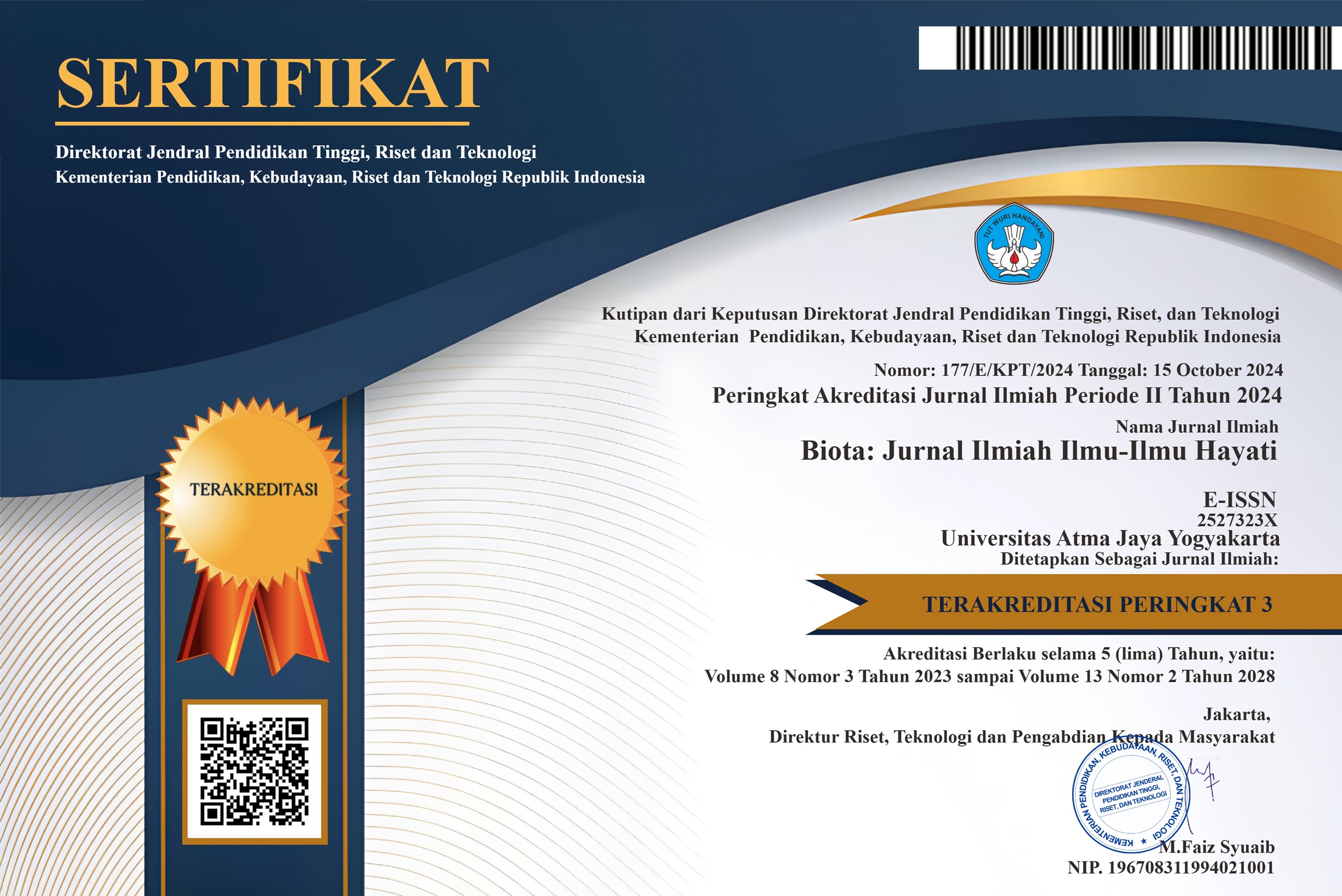The Effect of Corn (Zea mays) Cob Extract on the Growth of Bifidobacteria
DOI:
https://doi.org/10.24002/biota.v8i3.6942Keywords:
alkaline, Bifidobacterium, corn cob, total plate count, xylanAbstract
Corncob is a source of dietary fiber, contains xylan polysaccharides (12.4%–31.94%), and is classified as the highest xylan-producing source compared to other agricultural wastes. Human digestive enzymes cannot degrade xylan but can be enzymatically degraded by lactic acid bacteria (LAB) through fermentation. This research aimed to evaluate the effect of corncob extract on the growth of Bifidobacterium. Corncob extract is obtained through alkaline extraction. The growth of Bifidobacterium bifidum FNCC 0462 and Bifidobacterium longum FNCC 0463 was observed through in vitro fermentation for 48 h using the total plate count (TPC) method. Bifidobacterium bifidum FNCC 0462 showed the ability to ferment corn cob extract for 48 h of fermentation with the highest growth at 8 h of fermentation (4,08 log10 CFU/mL) while B. longum FNCC 0463 was able to grow up to 16 h of fermentation only. The results indicated that corncob extract could support B. bifidum FNCC 0462 growth.
References
Anukam, A. I., Goso, B. P., Okoh, O. O., & Mamphweli, S. N. (2017). Studies on characterization of corn cob for application in a gasification process for energy production. Journal of Chemistry 2017: 1–9.
Atolia, E., Cesar, S., Arjes, H. A., Rajendram, M., Shi, H., Knapp, B. D., Khare, S., Aranda-Diaz, A., Lenski, R. E., & Huang, K. C. (2020). Environmental and physiological factors affecting high-throughput measurements of bacterial growth. Molecular Biology and Physiology 11(5): 1–5.
Ariestanti, C. A., Sejati, R. A., Setyaratri, F. T., & Meliana, F. A. (2022). The potency of corn (Zea Mays) cob waste as a prebiotic candidate to support the growth of bifidobacterium longum : a preliminary study. Sciscitatio 3(1) : 47–52.
Arumugam, M., Raes, J., Pelletier, E., Le Paslier, D., Yamada, T., Mende, D. R., et al. (2011). Enterotypes of the human gut microbiome. Nature 473: 174–180.
Bajpai, P. (2014). Xylan. Xylanolytic Enzymes. Elsevier. Amsterdam.
Baker, J. T., Duarte, M. E., Holanda, D. M., & Kim, S. (2021). Friend or foe? impacts of dietary xylans, xylooligosaccharides, and xylanases on intestinal health and growth performance of monogastric animals. Animals 11(609): 1–25.
Blandino, M., Fabbri, C., Soldano, M., Ferrero, C., & Reyneri, A. (2016). The use of cobs, a by-product on maize grain, for energy production in anaerobic digestion. Italian Journal of Agronomy 11(754): 195–198.
Broekaert, W. F., Courtin, C. M., Verbeke, K., de Wiele, T. V., Verstraete, W., & Delcour, J. A. (2011). Prebiotic and other health-related effects of cereal-derived Arabinoxylans, Arabinoxylan-Oligosaccharides, and Xylooligosaccharides. Critical Reviews in Food Science and Nutrition 51: 178–194.
Chapla, D., Pandit, P., & Shah, A. (2011). Production of Xylooligosaccharides from corncob xylan by fungal xylanase. Bioresource Technology 115: 215–221.
Christica, I. & Julia, R. (2018). Activated carbon utilization from corn cob (Zea mays) as a heavy metal adsorbent in industrial waste. Asian Journal of Pharmaceutical Research and Development 6(5): 1–4.
Couvert, O., Marie-Laure, D., Anne, L., Thuault, D., & Huchet, V. (2018). Modelling the effect of oxygen concentration on bacterial growth rates. Food Microbiology 77: 21–25.
De Filippo, C., Cavalieri, D., Di Paola, M., Ramazzotti, M., Poullet, J. B., Massart, S., Collini, S., Pieraccini, G., & Lionetti, P. (2010). Impact of diet in shaping gut microbiota revealed by a comparative study in children from europe and rural africa. Proc. Natl. Acad. Sci. 107(33): 14691–14696.
Egan, M., & Van Sinderen, D. (2018). Carbohydrate metabolism in bifidobacteria. In: Paola Mattarelli, Bruno Biavati, Wilhelm H. Holzapfel, and Brian J. B. Wood (Eds.). The Bifidobacteria and Related Organisms. Academic Press. London.
Flint, H. J., Scott, K. P., Duncan, S. H., Loius, P., & Foranco, E. (2012). Microbial degradation of complex carbohydrates in the gut. Gut Microbes 3(4): 289–306.
Gonzalez, J. M. and Aranda, B. (2023). Microbial growth under limiting conditions-future perspectives. Microorganisms 11(1641): 1–21.
Grootaert, C., Delcour, J. A., Courtin, C. M., Broekaert, W. F., Verstraete, W., & Van de Wiele, T. (2007). Microbial metabolism and prebiotic potency of arabinoxylan oligosaccharides in the human intestine. Trends in Food Science & Technology 18: 64–71.
Hendrati, P. M., Kusharyati, D. F., Ryandini, D., & Oedjijono. (2017). Characterization of bifidobacteria from infant feces with different mode of birth at Purwokerto, Indonesia. Biodiversitas 18(3): 1265–1269.
Hidayat, N., Hidayat, A. N., & Gozan, M. (2019). Preliminary design of corncob based furfural plant. AIP Conf. Proc., 2062 (020048):1-9.
Ike, M. & Tokuyasu, K. (2018). Cellulase production of Trichoderma reesei (Hypocrea jecorina) by continuously fed cultivation using sucrose as primary carbon source. Journal of Applied Glycoscience 65(4): 51–56.
Jaskari, J., Kontula, P., Siitonen, A., Jousimies-Somer, H., Mattila-Sandholm, T., & Poutanen, K. (1998). Oat ꞵ-Glucan and Xylan Hydrolysates as selective substrates for bifidobacterium and Lactobacillus Strains. Applied Microbiology and Biotechnology 49: 175–181.
Levantovsky, R., Allen-Blevins, C. R., & Sela, D. A. (2018). Nutritional requirements of bifidobacteria. In: Paola Mattarelli, Bruno Biavati, Wilhelm H. Holzapfel, and Brian J. B. Wood (Eds.). The Bifidobacteria and Related Organisms. Academic Press. London.
Li, X., Liu, Q., Si, C., Lu, L., Luo, C., Gu, X., Liu, W., & Lu, X. (2018). Green and efficient production of furfural from corn cob over H-ZSM-5 using γ-Valerolactone as solvent. Industrial Crops & Products 120(2018): 343–350.
Liu, Y., Xu, X., Qu, B., Liu, X., Yi, W., & Zhang, H. (2021). Study on adsorption properties of modified corn cob activated carbon for mercury ion. Energies 14(4483): 2–22.
Mendis, M. & Simsek, S. (2013). Arabinoxylans and human health. Food Hydrocolloids 30(2013): 1–5.
Mıdık, F., Tokatlı, M., Elmacı, S. B., & Özçelik, F. (2020). Influence of different culture conditions on exopolysaccharide production by indigenous lactic acid bacteria isolated from pickles. Arch Microbiol 202(4): 875–885.
Oliveira, E. E., Silva, A. E., Júnior, T. N., Gomes, M. C., Aguiar, L. M., Marcelino, H. R., Araújo, I. B., Bayer, M. P., Ricardo, N. M. P. S., Oliveira, A. G., & Egito, E. S. T. (2010). Xylan from corn cobs, a promising polymer for drug delivery: production and characterization. Bioresource Technology 101(2010): 5402–5406.
Rahmawati, G., Rachmawati, F. N., & Winarsi, H. (2014). Aktivitas superoksida dismutase tikus diabetes yang diberi ekstrak batang kapulaga dan glibenklamid. Scripta Biologica 1(3): 197–201.
Richana, N., Irawadi, T. T., Nur, M. A., Sailah, I., Syamsu, K., & Arkenan, Y. (2007). Ekstraksi xilan dari tongkol jagung. J. Pascapanen 4(1): 38–43.
Robinson, P. K. (2015). Enzymes: principles and biotechnological applications. Essays Biochem 59: 1–41.
Ruiz, L., Ruas-Madiedo, P., Gueimonde, M., de los Reyes-Gavilán, C. G., Margolles, A., Sánchez, B. (2011). How do bifidobacteria counteract environmental challenges? mechanisms involved and physiological consequences. Genes Nutr 6: 307–318.
Sasmitaloka, K. S., Arif, A. B., Juniawati, Winarti, C., Hayuningtyas, M., Ratnaningsih, & Richana, N. (2019). Xylan production from corn cobs for isolation of xylanase-producing bacteria. IOP Conf. Series: Earth and Environmental Science 309: 1–8.
Schnorr, S. L., Candela, M., Rampelli, S., Centanni, M., Consolandi, C., Basaglia, G., Turroni, S., Biagi, E., Peano, C., Severgnini, M., Fiori, J., Gotti, R., Bellis, G. D., Luiselli, D., Brigidi, A., Marlowe, F., Henry, A. G. dan Crittenden, A. N. (2014). Gut microbiome of the hadza hunter-gatherers. Nature Communications 5(3654): 1–12.
Sharah, A., Karnila, R., & Desmelati. (2015). Pembuatan kurva pertumbuhan bakteri asam laktat yang diisolasi dari ikan peda kembung (Rastrelliger sp.). JOM 10: 1–8.
Sporck, D., Reinoso, F. A. M., Rencoret, J., Gutiérrez, A., del Rio, J. C., Ferraz, A., & Milagres, A. M. F. (2017). Xylan extraction from pretreated sugarcane bagasse using alkaline and enzymatic approaches. Biotechnology for Biofuels 10(296): 1–11.
Süle, J., Kõrösi, T., Hucker, A., & Varga, L. (2014). Evaluation of culture media for selective enumeration of bifidobacteria and lactic acid bacteria. Brazilian Journal of Microbiology 45(3): 1023–1030.
Takada, M., Niu, R., Minami, E., & Saka, S. (2018). Characterization of three tissue fractions in corn (Zea mays) Cob. Biomass and Bioenergy 115: 130–135.
Van Eylen, D., van Dongen, F., Kabel, M., & de Bont, J. (2011). Corn fiber, cobs and stover: enxyme-aided saccharification and co-fermentation after dilute acid pretreatment. Bioresource Technology 102(2011): 5995–6004.
Vlasova, A. N., Kandasamy, S., Chattha, K. S., Rajashekara, G., & Saif, L. J. (2016). Comparison of probiotic lactobacilli and bifidobacteria effects, immune responses and rotavirus vaccines and infection in different host species. Vet Immunol Immunopathol 172: 72–84.
Wachirapakorn, C., Pilachai, K., Wanapat, M., Pakdee, P., & Cherdthong, A. (2016). Effect of ground corn cobs as a fiber source in total mixed ration on feed intake, milk, yield and milk composition in tropical lactating crossbred holstein cows. Animal Nutrition Journal 2(4): 334–338.
Wang, Q., Qi, W., Wang, W., Zhang, Y., Leksawasdi, N., Zhuang, X., Yu, Q., & Yuan, Z. (2019). Production of furfural with high yields from corncob under extremely low water/solid ratios. Renewable Energy 144(2019): 139–146.
Wang, X., Xia, K., Yang, X., & Tang, C. (2019). Growth strategy of microbes on mixed carbon sources. Nature Communications 10:1279.
Wang, Y., Wu, J., Lv, M., Shao, Z., Hungwe, M., Wang, J., Bai, X., Xie, J., Wang, Y., & Geng, W. (2021). Metabolism characteristics of lactic acid bacteria and expanding applications in food industry. Frontiers in Bioengineering and Biotechnology 9: 1–19.
Downloads
Published
How to Cite
Issue
Section
License
Copyright (c) 2023 Catarina Aprilia Ariestanti, Ribka Ananda Sejati, Charis Amarantini

This work is licensed under a Creative Commons Attribution-NonCommercial 4.0 International License.
Authors who publish with Biota : Jurnal Ilmiah Ilmu-Ilmu Hayati agree to the following terms:
- Authors retain copyright and grant the Biota : Jurnal Ilmiah Ilmu-Ilmu Hayati right of first publication. Licensed under a Creative Commons Attribution-NonCommercial 4.0 International License that allows others to share the work with an acknowledgment of the work's authorship and initial publication in this journal.
- Authors are able to enter into separate, additional contractual arrangements for the non-exclusive distribution of the journal's published version of the work (e.g., post it to an institutional repository or publish it in a book), with an acknowledgment of its initial publication in Biota : Jurnal Ilmiah Ilmu-Ilmu Hayati, and as long as Author is not used for commercial purposes.













